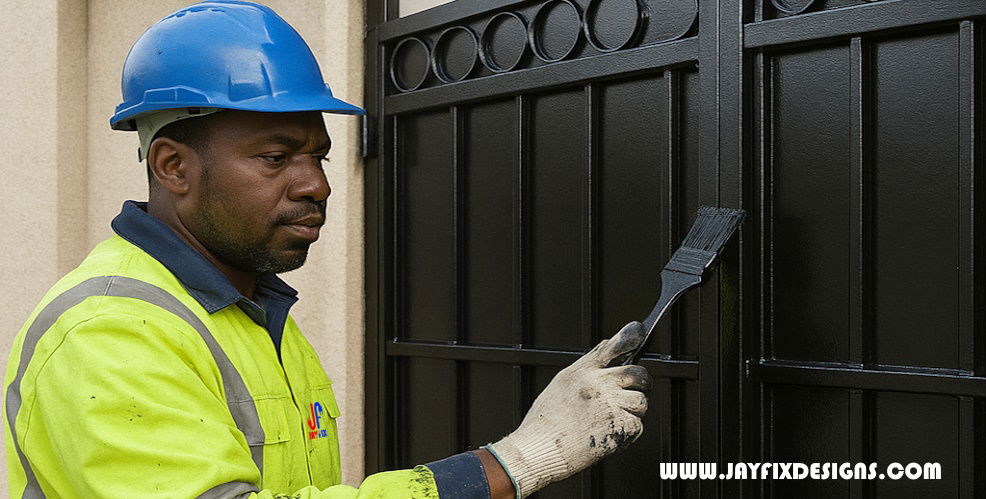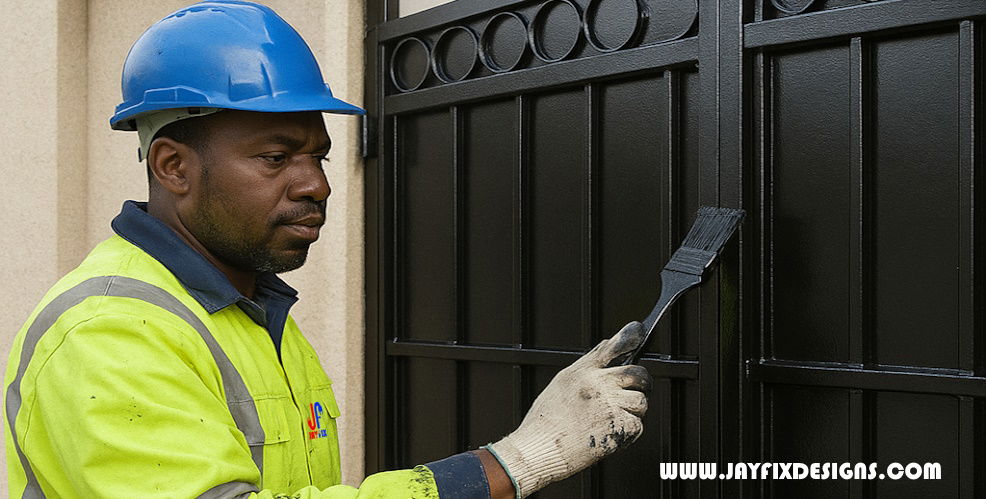
Metallic surfaces—whether gates, railings, furniture, or industrial fixtures—offer strength, durability, and visual appeal. However, painting metal isn’t as straightforward as painting wood or drywall. It requires proper technique, surface preparation, and an understanding of how paint interacts with metal. Done correctly, it not only beautifies but also protects metal against corrosion, wear, and the elements.Let’s look into the techniques, processes, and challenges of painting metal—and how to achieve smooth, long-lasting results.
🧰 1. Surface Preparation: The Foundation of a Quality Finish
Proper preparation is the most critical step in metal painting. Without it, even the best paint won’t last.
✅ Key Steps:
- Cleaning: Remove grease, dirt, dust, or oil using a degreaser or mild detergent.
- Rust Removal: Use sandpaper, wire brushes, or power tools to eliminate rust and loose paint.
- Sanding: Lightly sand to create a rough surface (profile) for better paint adhesion.
- Priming: Use a rust-inhibiting metal primer—especially important for iron and steel—to prevent oxidation.
Tip:
For galvanized or aluminum surfaces, use a self-etching primer to ensure paint grip.
🎯 2. Choosing the Right Paint for Metal
Different projects call for different paint types. The ideal choice depends on whether the item is indoor/outdoor, exposed to weather, or needs a specific finish.
🛠 Recommended Paints:
- Oil-based paints: Durable and water-resistant—ideal for outdoor metallic gates and grills.
- Acrylic latex paints: Suitable for indoor projects; easier to clean and lower in VOCs.
- Epoxy or enamel paints: Used for industrial and high-traffic applications due to high durability.
- Spray paints (for small objects): Offer even coats and faster application but require careful masking.
Finish Options:
- Glossy: Reflective, modern, and easy to clean.
- Matte/Satin: Subtle and elegant, perfect for decorative items.
- Hammered or Textured: Hides imperfections and adds a unique visual style.
🌀 3. Painting Techniques for Metal Surfaces
Whether using a brush, roller, or spray, technique matters greatly.
🖌 Brush and Roller:
- Use synthetic bristle brushes or foam rollers.
- Apply in thin, even coats.
- Brush in the same direction for uniformity.
🚿 Spray Painting:
- Ideal for large surfaces like gates, pipes, and metallic structures.
- Maintain consistent distance (6–12 inches) while spraying.
- Multiple light coats are better than one heavy one.
Artistic or Decorative Techniques:
- Visual painting or patterns: Stenciling or freehand designs on metal gates adds flair.
- Layering and fading: Creates depth and artistic impact, especially on display items.
- Color blocking: Using contrasting or complementary colors for a modern look.
⚠️ 4. Common Challenges in Metal Painting
Metal painting isn’t without its problems—especially in Kenya’s variable climate.
🧱 Rust & Corrosion:
- Problem: Rust bleeds through paint and weakens the surface.
- Solution: Sand thoroughly and use rust-neutralizing primers.
💧 Peeling or Flaking:
- Cause: Poor surface prep or incompatible paint.
- Solution: Use proper primers and ensure metal is dry and clean.
🌤 Weather Conditions:
- Avoid painting in extreme heat or high humidity.
- Ideal temperature: Between 10°C – 32°C (50°F – 90°F).
🕳 Inconsistent Coverage:
- Occurs with overly thick coats or poor-quality brushes.
- Use proper tools and apply thin layers with drying time in between.
✅ 5. Best Practices for Long-Lasting Metal Painting
- Always read paint labels for compatibility and drying times.
- Apply at least two coats of paint and seal with a topcoat if needed.
- Allow sufficient curing time (up to 24–48 hours) for durability.
- Regular maintenance: Wipe down painted metal and inspect for chips or rust.
🖼️ Painting as Both Protection and Art
Painting metal is more than maintenance—it's an opportunity to transform cold, industrial surfaces into elegant, expressive, and protected pieces. Whether it’s a black metallic gate gleaming in the sun or a colorfully patterned steel bench, the art of painting metal lies in the marriage of function and beauty.For projects that stand the test of time, always prioritize surface prep, use quality materials, and apply tested techniques. And when in doubt, call in professionals like JayFix Designs, where every coat tells a story of craftsmanship and care.



